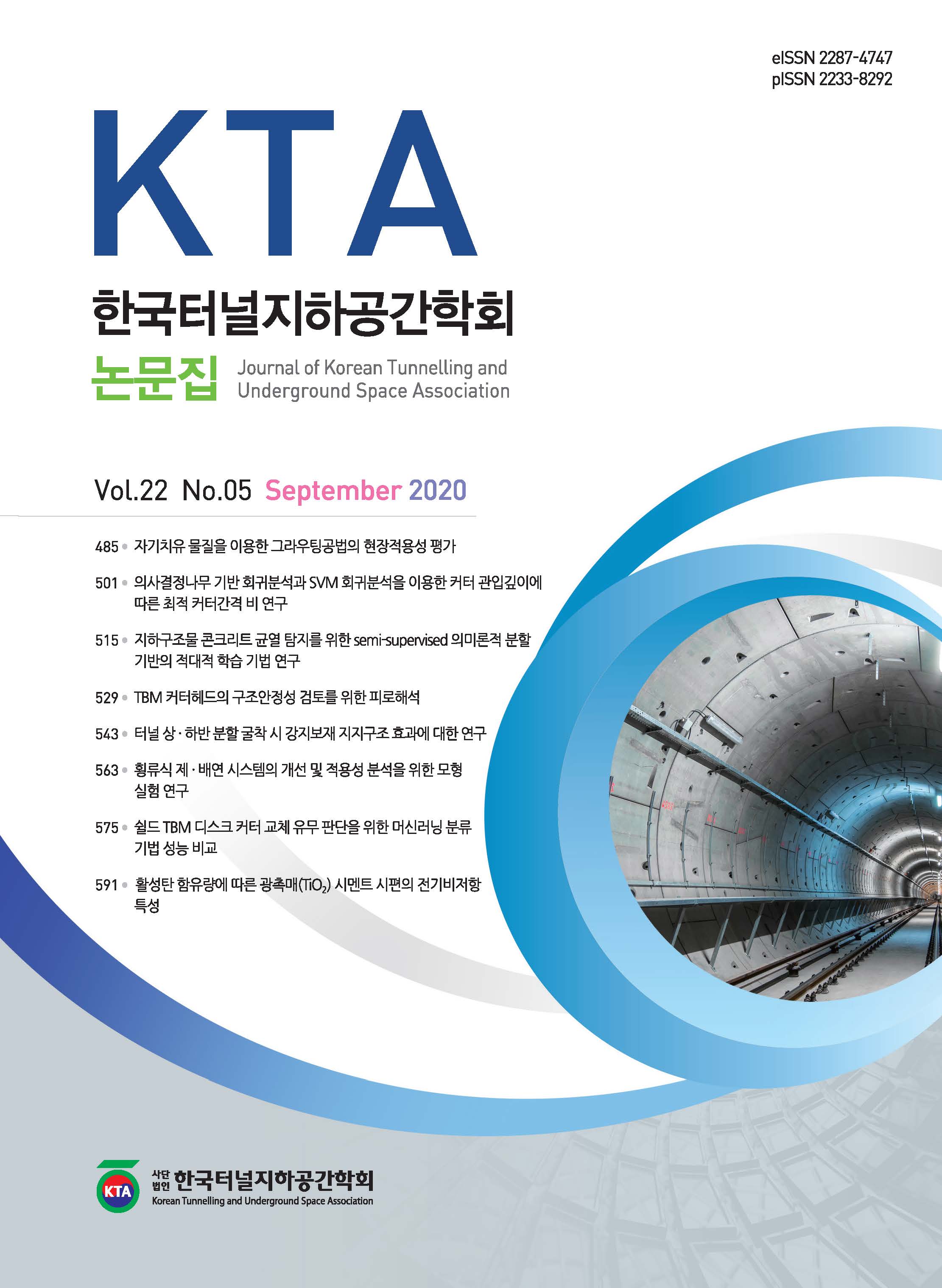(사)한국터널지하공간학회
- Log In/Sign Up
- P-ISSN2233-8292
- E-ISSN2287-4747
- KCI
 ISSN : 2233-8292
ISSN : 2233-8292
Article Contents
- 2024 (Vol.26)
- 2023 (Vol.25)
- 2022 (Vol.24)
- 2021 (Vol.23)
- 2020 (Vol.22)
- 2019 (Vol.21)
- 2018 (Vol.20)
- 2017 (Vol.19)
- 2016 (Vol.18)
- 2015 (Vol.17)
- 2014 (Vol.16)
- 2013 (Vol.15)
- 2012 (Vol.14)
- 2011 (Vol.13)
- 2010 (Vol.12)
- 2009 (Vol.11)
- 2008 (Vol.10)
- 2007 (Vol.9)
- 2006 (Vol.8)
- 2005 (Vol.7)
- 2004 (Vol.6)
- 2003 (Vol.5)
- 2002 (Vol.4)
- 2001 (Vol.3)
Fire resistance assessment of high strength segment concrete depending on PET fiber amount under fire curves
- Downloaded
- Viewed
Abstract
High strength concrete is not only vulnerable to the occurrence of spalling which generates the loss of cross-section in concrete structures but produces faster degradation in its mechanical properties than normal strength concrete in the event of fire. This study aims to evaluate fire resistance of high strength segment concrete with PET fibers mixed to prevent spalling under ISO834 (2hr) and RABT fire curve. As results, the samples without PET fibers show the concrete loss up to the depth of about 8 cm and 9.5 cm from the surface exposed to fire under ISO834 and RABT fire curve respectively. The samples mixed with PET fiber of 0.1% show no spalling under ISO834 fire curve and the spalled thickness of 6.5 cm under RABT fire curve after the fire tests. Finally, the sample mixed with PET fiber of 0.2% shows no spalling under RABT fire curve. The results indicate that the suitable amounts of PET fiber for securing fire resistance performance of this high strength segment concrete are 0.1% under ISO834 fire curve and 0.2% under RABT fire curve. However, even though spalling does not occur, it is necessary to repair the deterioration of concrete up to 4 cm from the surface exposed to fire after fire.
- keywords
- 화재저항성, 세그먼트라이닝, PET섬유, ISO834 화재곡선, RABT 화재곡선, Fire resistance, Segment lining, PET fiber, ISO834 fire curve, RABT fire curve
Reference
1. Beard, A., Carvel, R. (2004), THE HANDBOOK OF TUNNEL FIRE SAFETY, Thormos Telford, pp. 113-121.
2. Beer, G. (2010), “Technology innovation in underground construction”, CRC Press, pp. 299-314.
3. Eurocode 2 (2004), Design of concrete structures, Part 1-2: General rules - Structural Fire Design, EN 1992-1-2: 2004, December, Brussels, pp. 32-34.
4. Hertz, K.D. (2003), “Limits of spalling of fire-exposed concrete”, Fire Saf. J., Vol. 38, pp. 103-116.
5. ITA (2004), Guidelines for structural fire resistance for road tunnels, Working Group No. 6 Maintenance and Repair, pp. 5-9.
6. Japan Research Society of New Technology for Shield Tunnelling (2001), New Technology for Shield Tunnelling, Doboku books[in japanese]; シールドトンネルの新技術硏究會(2001), “シールドトンネルの新技術”, 土木工學社.
7. Khoury, G.A. (1992), “Compressive strength of concrete at high temperatures: a reassessment”Magazine of Concrete Research, Vol. 44(161), December, pp. 291-309.
8. Khoury, G.A., (2000). “Effect of fire on concrete and concrete structures” Prog. Struct. Engng Mater. Vol. 2, pp. 429-447.
9. Khoury, G.A., Majorana, C.E., Pesavento, F., Schrefler, B.A. (2002), “Modelling of heated concrete”, Magazine of Concrete Research, Vol. 54, No. 2, pp. 77-101.
10. Khoury, G.A. (2008), “Passive fire protection of concrete structures”, Structures & Buildings, Vol. 6, SB3, pp. 35-45.
11. Kim, S.B., Nam, J.W., Yi, N.H., Kim, J.J.H., Choi, H.S. (2008), “Flexural behavior of hwangtoh concrete beams with recycled PET fiber.” Journal of the Korea Concrete Institute, Vol. 20, No. 5, pp. 619-626.
12. Kodur, V.K.R., Phan, L. (2007), “Critical factors governing the fire performance of high strength concrete systems.” Fire Saf. J., Vol. 42, pp. 482-488.
13. Lee, G.P., Park, Y.T., Choi, S.W., Bae, G.J., Chang, S.H., Kang, T.S., Lee, J.S. (2012), “An experimental study on mechanical behavior of shield segment with high-strength concrete and high-tension bar”, Journal of Korean Tunnelling and Underground Space Association, Vol. 14, No. 3, pp. 215-230.
14. Phan, L.T. (1996), Fire Performance of High-Strength Concrete: A Report of the State-of-the-Art, NISTIR 5934, National Institute of Standards and Technology, pp. 54-56.
15. Won, J.P., Park, C.G., Choi, M.J. (2008), “Bond and flexural properties of fiber reinforced concrete with recycled poly ethylene terephthalate waste”, Journal of the Korean Society of Civil Engineers, Vol. 28, No. 3A, pp. 401-406.
- Downloaded
- Viewed
- 0KCI Citations
- 0WOS Citations
